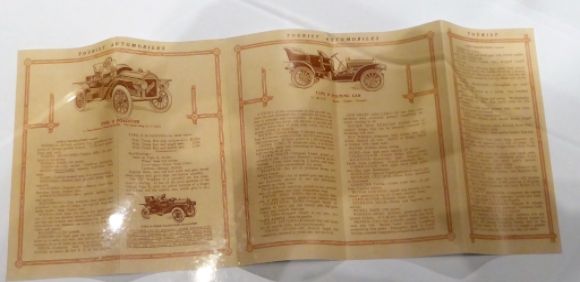The automobile, a technological innovation which combined a mechanical power source (steam, electric, or internal combustion engine) and a carriage or wagon, was originally developed in Europe, but in the early twentieth century it began to be one of the defining elements of American culture. The Los Angeles County Museum of Natural History has a few displays on the automobile and the oil industry in Southern California.
 Shown above is an early Tourist automobile manufactured by the Auto Vehicle Company of Los Angeles. The company was founded in 1902 and went out of business in 1910 after producing about 5,000 Tourist automobiles.
Shown above is an early Tourist automobile manufactured by the Auto Vehicle Company of Los Angeles. The company was founded in 1902 and went out of business in 1910 after producing about 5,000 Tourist automobiles.
 Another view of the 1902 Tourist.
Another view of the 1902 Tourist.
 Shown above is a 1908 brochure for Tourist automobiles.
Shown above is a 1908 brochure for Tourist automobiles.
 Shown above is the 1908 parts price list brochure for Tourist automobiles.
Shown above is the 1908 parts price list brochure for Tourist automobiles.
According to the Museum display:
“Before there were auto mechanics, fixing cars was problematic. Owners would hire carriage makers for bodywork and blacksmiths or machinists for structural or engine work. Sometimes they would send to the factory for manuals and spare parts and attempt the repairs themselves.”
 Shown above is a gas pump from 1910. The early gas pumps were usually located outside of hardware stores and general stores.
Shown above is a gas pump from 1910. The early gas pumps were usually located outside of hardware stores and general stores.
 Shown above is an oil pump jack from the 1920s.
Shown above is an oil pump jack from the 1920s.
According to the Museum display:
“Edward L. Doheny’s 1892 discovery of oil at Second Street and Glendale Boulevard in downtown set off on oil boom. By 1897, the city’s 500 oil derricks competed with farm fields and orchards. Drilling activity reached new heights in the 1920s, when major finds were made. The biggest strikes were in Huntington Beach in 1920, and Santa Fe Springs and Signal Hill in 1921. The huge oil fields changed the environment and the built landscape as oil spills polluted the soil and oil derricks crowded out farmlands and homes.”


